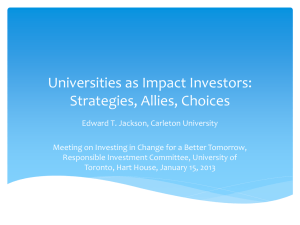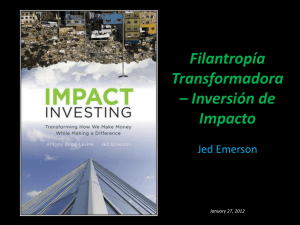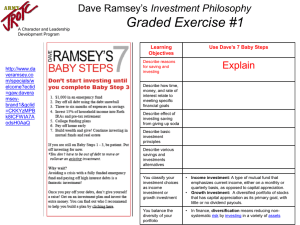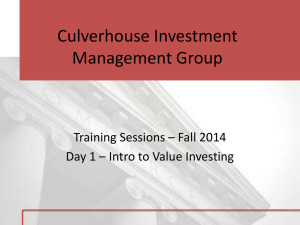to view his Powerpoint slides - Canadian Centre for Ethics in Public
advertisement
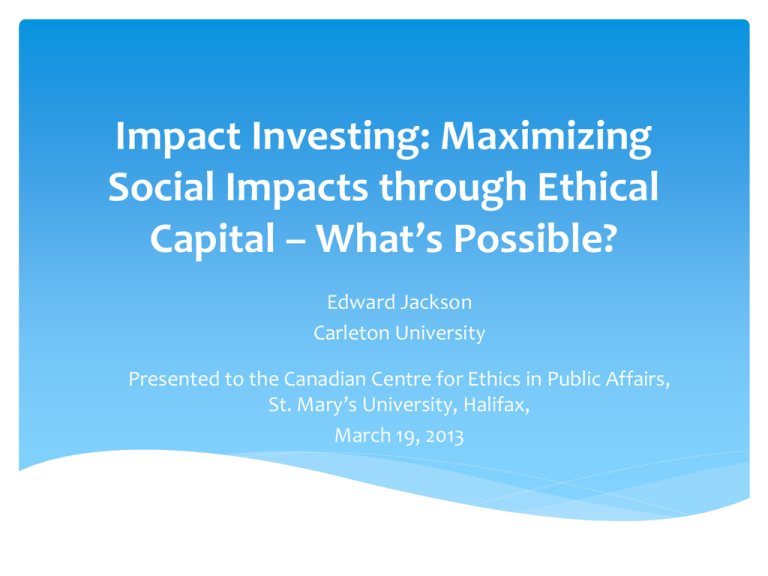
Impact Investing: Maximizing Social Impacts through Ethical Capital – What’s Possible? Edward Jackson Carleton University Presented to the Canadian Centre for Ethics in Public Affairs, St. Mary’s University, Halifax, March 19, 2013 What is Ethical Capital? Ethical capital constitutes financial assets that are mobilized and invested according to the system of moral ideals, or code of values, of the owners of the capital. Examples: Ethically screened stocks on the stock markets Ethically targeted direct investments, or impact investments. 2 Examples of Impact Investments A loan to a renewable energy business, Husk Power, in Bihar, India-biomass gasification of rice husk, providing rural employment Mortgage financing for an affordable housing project in Oakland, California-routed through Pacific Community Ventures, a community-development finance institution 3 Impact Investing: Part of the Future of Finance Along with: Government tax revenues Domestic private investment Foreign direct investment Overseas development assistance Charitable grants Other innovative finance instruments 4 Current Context Slow economic growth globally High unemployment and growing inequality Pressure to reduce western aid budgets Continued ascendance of new economic powers: China, India, Brazil, Korea, Indonesia Increased importance of G-20 in global governance Increased development assistance and trade on the part of the new powers Need and opportunity to lever private sector capital to address pressing social issues 5 New Options for Innovative Finance Ten years of R&D by UNDP, OECD, World Bank, think tanks GAVI vaccine bonds: $7B+ in long-term government pledges New options proposed that can be driven by G-20 countries: SWF Infrastructure Fund Financial Transaction Tax (Tobin Tax) Remittance Transfer Savings Diaspora Bonds Fuel Tax (Global Component) (see Gates, 2011) 6 Impact Investing: “actively placing capital in businesses and funds that generate social and/or environmental good and at least return nominal principal to the investor” 7 Source: Freireich and Fulton, Investing for Social and Environmental Impact, 2009 Investments intended to create positive impact beyond financial return Provide capital • Transactions currently tend to be private debt or equity investments • We expect more publicly traded investment opportunities will emerge as the market matures Businesses designed with intent • The business (fund manager of company) into which the investment is made should be designed with intent to make a positive impact • This differentiates impact investments from investments that have unintentional positive social or environmental consequences Expect financial returns • The investment should be expected to return at least nominal principal • Donations are excluded • Market-rate or market-beating returns are within scope … to generate positive social and/or environmental benefit • Positive social and/or environmental impact should be part of the stated business strategy and should be measured as part of the success of the investment 8 Source: JP Morgan, Rockefeller Foundation and GIIN, 2010 Impact investing: Core Definitional Elements Intention Tangible Impacts “Investments intended to create positive impact beyond financial returns” Source: O’Donohoe, Leijonhufvud and Saltuk, 2010 9 Impact Investing: Mapping Returns Source: adapted from Monitor Institute 2009, via Rockefeller Foundation , 2011 High Financial First i Market Related Traditional Investments Impact Investments • Financial Returns Impact First SRI (“Do No Harm”) • Subsidized Investments Below Market Low Impact and Low Financial Returns Philanthropy • Grants Low Social Returns High Actors in the Impact Investing Industry 11 Source: Harji and Jackson, 2012 Describing Impact Investing Around the World Source: Harji and Jackson, 2012 12 Mapping the Impact Investing Industry Source: Harji and Jackson, 2012 13 Types of Impact Investment Products Private debt (loans, guarantees) Government debt (loans, guarantees) Equity-like debt (e.g., convertible bonds, warrants) Private equity (direct purchase of shares in enterprise) Social stock exchange units (purchase of tradable shares via an organized market) Social impact bonds (premium on financial return to private investors for non-profit achievement of outcome targets) 14 More Types of Impact Investment Products Program related investments (usually debt) of foundations and endowments Deposits in social banks, credit unions, CDFIs Community investment notes Disability savings plan (Canada) 15 Local Impact Investors Impact investment funds of banks Micro-enterprise, SME and non-profit financing from credit unions Micro-enterprise, SME and non-profit financing by Business Development Bank of Canada CED Investment Funds PRIs of foundations Loans and equity investments by high net-worth individuals and families Social impact bonds 16 What Impact Investing is Not Not a silver bullet / panacea Not implying that every social issue can be solved through market-based approaches Not replacing the important role of philanthropy Not an excuse for governments to ignore their obligations to marginalized populations or their obligations to redistribute wealth 17 The Potential of Impact Investing The ability to unlock new types of capital to address a range of social issues, and to combine capital in creative ways An opportunity to address the limitations of traditional investment approaches that narrowly focus on financial returns A desire by more wealthy investors to generate both financial and social returns 18 Capital Growth 19 Value of Reported Investments, by Region, 2011 Source: Saltuk, Bouri and Leung, Insight into the Impact Investment Market, 2012 20 Unlocking Capital at Scale: Vaccine Bonds Impact investors provide the upfront capital to stimulate vaccine research and development Investments backed by international aid commitments 2008: International Finance Facility (IFFI) for Immunization issued bonds which raised the equivalent of over $1 billion 21 22 Source: Monitor and Acumen Fund, 2012 Case Study: Global Easy Water Products Stages of Business Development of GEWP 23 Source: Monitor and Acumen Fund, 2012 Measuring Social Impact: Interrogating the Theory of Change The key to an effective social impact measurement system is a clear theory of change A theory of change sets out, usually in a visual format, the investor’s theory of how the channeling of capital into business and social activities undertaken will result in change in the lives of employees, community members or other key stakeholder groups and what indicators are used to judge the success of these efforts A theory of change also depicts the key assumptions and potential obstacles expected in trying to achieve this social impact A theory of change evolves and adapts through experience and learning 24 25 Source: Root Capital, 2011 Theory of Change: Impact Investing Initiative Housing Health Care Clean Water Sanitation Energy Lives of poor and vulnerable improved The poor and vulnerable can capture real benefits Availability of affordable products and services improved Income generating activities expanded Physical environment improved Wage-levels permit real income gains for the poor Profitability of businesses ensure surplus for allocation to impacts Private business corporations engaged Small and medium enterprises engaged Micro enterprises engaged Social enterprises engaged Local impact investment funds engaged Number and size of for-profit impact investments increased Global economic conditions encourage investing Regulatory, fiscal and reputational incentives encourage investing Source: Jackson and Harji, 2012 Pension funds – public Foundations, – private – engaged endowments engaged Cost-sharing by partners is sustained Private equity funds engaged Family offices engaged Non-profit social / Government green funds engaged agencies engaged Retail investors engaged For-profit impact investment efficiently placed by full ecosystem Collective action platforms created Coalition-building drives policy change Intermediaries’ business models sustain expansion Competing systems co-exist Industry infrastructure developed Intermediaries scaled Policy reforms instituted Catalyzing activities undertaken Grants for collective action platforms approved Grants for industry standards approved Grants for scaling intermediaries approved PRIs for scaling intermediaries executed Grants for research and advocacy approved Communications outreach carried out Brokerage and networking carried out 26 Measuring Social Impact: A Sample of Tools and Approaches Language: Impact Reporting and Investment Standards (IRIS) Enterprise Governance: B Corporations Investor Ratings: Global Impact Investing Ratings System (GIIRS) Approaches/Uses: Rating, Assessment, Management Tools: Social Return on Investment 27 28 Source: GIIN, 2011 29 Source: GIIRS, 2011 Type and Maturity of Measurement Method 30 Source: Social Venture Technology Group, 2008 Where Measurement Approaches are Applied 31 Source: Social Venture Technology Group, 2008 Observations on Social Impact in Impact Investing Impact investing field has been “metrics rich but data poor”, but this is changing Investor focus dominates Sectoral metrics vary (e.g., microfinance) Moving beyond data collection analysis Tension between centralized and decentralized systems persists Important to understand and apply the models and tools of social impact assessment 32 When Things Go Wrong Bad things can happen to good ideas and good people Managing the social and business dimensions at the same time is challenging Business environments are volatile The private sector fails all the time, but it is private! Capital and measurement are not enough 33 What To Do? Short-Term Responses Evaluate on a case-by-case basis and programs as a whole Protect vulnerable parties Undertake SROI and other value-analysis studies Rebuild the business plan, reposition the enterprise Ensure strong business leadership, financial reporting Draw lessons for future investments and programs Strengthen regulation and monitoring Get back on the horse and keep riding! 34 What to Do? Long-Term Responses Build a cohort of new leaders in business, finance and the social sector with the skills and commitment to design and execute impact investments and social enterprises successfully Develop targeted training programs jointly designed by community, government, business and educational stakeholders, using case studies of both failure and success Increase resources for monitoring, evaluation, regulation and mentoring 35 Accelerating Impact Investing Increase the velocity of: Evaluating, monitoring, learning and improving Scaling up capital pools Diversifying investment products and services Strengthening the capacity of social enterprises to receive and use capital Refining cost-effective impact-measurement tools Building the leaders of the future 36 Resources: Accelerating Impact http://www.rockefellerfoundation.org//uploads/images/fda23ba9-ab7e-4c83-9218-24fdd79289cc.pdf 37 Resources Publications Bugg-Levine, A. and J. Emerson. Impact Investing: Transforming How We Make Money While Making a Difference. 2011. Gates, B. “Innovation with Impact: Financing 21st Century Development.” Report to the G-20 Leaders, Cannes, 2011. Godeke, S. “Building a Healthy & Sustainable Social Impact Bond Market: The Investor Landscape.” Godeke Consulting and Rockefeller Foundation, 2012. JP Morgan, GIIN, Rockefeller Foundation. “Impact Investments: An Emerging Asset Class.” 2010. - Monitor and the Acumen Fund. “From Blueprint to Scale: The Case for Philanthropy in Impact Investing.” 2012. Monitor Institute. “Investing for Social and Environmental Impact: A Design For Catalyzing An Emerging Industry.” 2009. SVT Group. “Catalog of Approaches to Impact Measurement.” 2008. United National Development Program. “Innovative Financing for Development: A New Model for Development Finance.” 2011. 38 Resources Organizations Carleton Centre for Community Innovation carleton.ca/ccci GIIRS giirs.org Global Impact Investing Network thegiin.org MaRS Centre for Impact Investing impactinvesting.marsdd.com Purpose Capital purposecap.com Social Investment Organization socialinvestment.ca SROI Network (Canada) sroi-canada.ca 39 Contact Information Edward Jackson edward_jackson@carleton.ca 40
